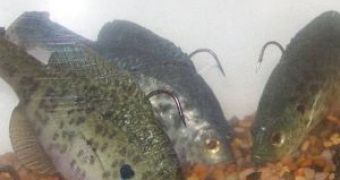One of the most common freshwater fish species in North America is used to protect drinking water from terrorists and accidental contamination.
Big cities in USA are using this biological monitoring system.
Fishes are kept in tanks constantly replenished with water from the municipal supply, and sensors in each tank register changes in the breathing, heartbeat and swimming patterns of the bluegills that occur in the presence of toxins.
This species was chosen because of its availability and an established database on their response to toxins.
"Nature's given us pretty much the most powerful and reliable early warning center out there," said Bill Lawler, co-founder of Intelligent Automation Corp., a Southern California company that makes and sells the bluegill monitoring system.
Bluegills can react to a wide range of chemicals and detect earlier small amounts of toxins that man made sensors.
"It's a high-tech technology that has been brought to this new millennium because of advanced hardware and software capabilities." said Tom Shedd, a biologist with the U.S. Army Center for Environmental Health Research in Fort Detrick, Maryland.
Since the terrorist attacks of September 11, 2001, federal law has required nearly all communities to monitor their drinking water systems against terrorist or other intentional acts.
Big cities monitor constantly employing systems against chemical and biological agents.
"But electronic protection systems can trace only the toxins they are programmed to detect," Lawler said. Bluegills are a hardy species about the size of a human hand.
They are highly sensitive to chemical contamination in their environment, and when exposed to toxins, they suffer breathing changes. The fish version of coughing, flexing their gills to expel unwanted particles.
"The Army started development of its early-warning system-now sold under the commercial name 1090 Intelligent Aquatic BioMonitoring System-about six years ago," Shedd says.
The system monitors the behavior of individuals in a tank where dechlorinated water flows at reservoirs or treatment plants.
Fishes' reactions in the tank conditions such as temperature, acidity, and dissolved oxygen levels are analyzed by a complex software.
When at least six of the fish present an abnormal behavior, the computer calls or emails the technician on duty.
To keep the fish from being stressed or sick, the fishes "work" for two weeks and after that are replaced by other individuals, to keep them away from stress or sickness.
A month ago, the system was employed in San Francisco.
"It gave us the best of both worlds, which is basically all the benefits that come from nature and the best of high-tech," said Susan Leal, general manager of the San Francisco Public Utilities Commission.
In New York City, the system has been functioning since 2002 and they are seeking to expand it.
At least in one instance the system detected two hours earlier than other detection devices a toxin (a diesel spill) into the water supply.
"During routine cleanings in the New York City and San Francisco reservoirs, the fish caused an alert after divers kicked up sediment about 40 miles (64 kilometers) away," Shedd says.
"There's a lot of emphasis on their ability to deter terrorism, but they are also doing a lot in terms of potential watershed monitoring and accidental chemical spills in source water," said Bill Lawler of Intelligent Automation Corporation (IAC) in Poway, California.
"The biomonitoring unit is currently on loan from the government, but plans are underway to purchase and expand the system," says Ian Michaels, a spokesperson for the New York City Department of Environmental Protection, which supplies water to nine million people.
"We considered it to be worth investigating as an additional layer of security," Michaels said, adding that "other tests-literally tens of thousands every year-are also performed to ensure safe drinking water. "
But the bluegills have their limitations.
Till now, they successfully detected at least 30 toxic chemicals, like cyanide, organic solvents, heavy metals, oil products or pesticides, but they cannot detect biological threats (germs).
Still, more than a dozen other cities have ordered the anti-terror apparatus which was originally developed for the Army and starts at around $45,000. "The push for aquatic biomonitoring first took place in Europe about 20 years ago after a major chemical spill in Switzerland," according to Shedd.
Fishes, clams and daphnia are used as indicators of chemical changes.
"It's just recent that the U.S. has become interested in this capability," Shedd said.
"It's one tool in an arsenal of tools to monitor for water quality and to protect surface waters," he added.
"It's not a stand-alone technology. It's a complement to the current technology we already have out there." San Francisco is planning to install two more systems.
"It provides us an added level of detection of the unknown," said Tony Winnicker, a spokesman for the city's Public Utilities Commission.
"There's no computer that's as sophisticated as a living being."

 14 DAY TRIAL //
14 DAY TRIAL //